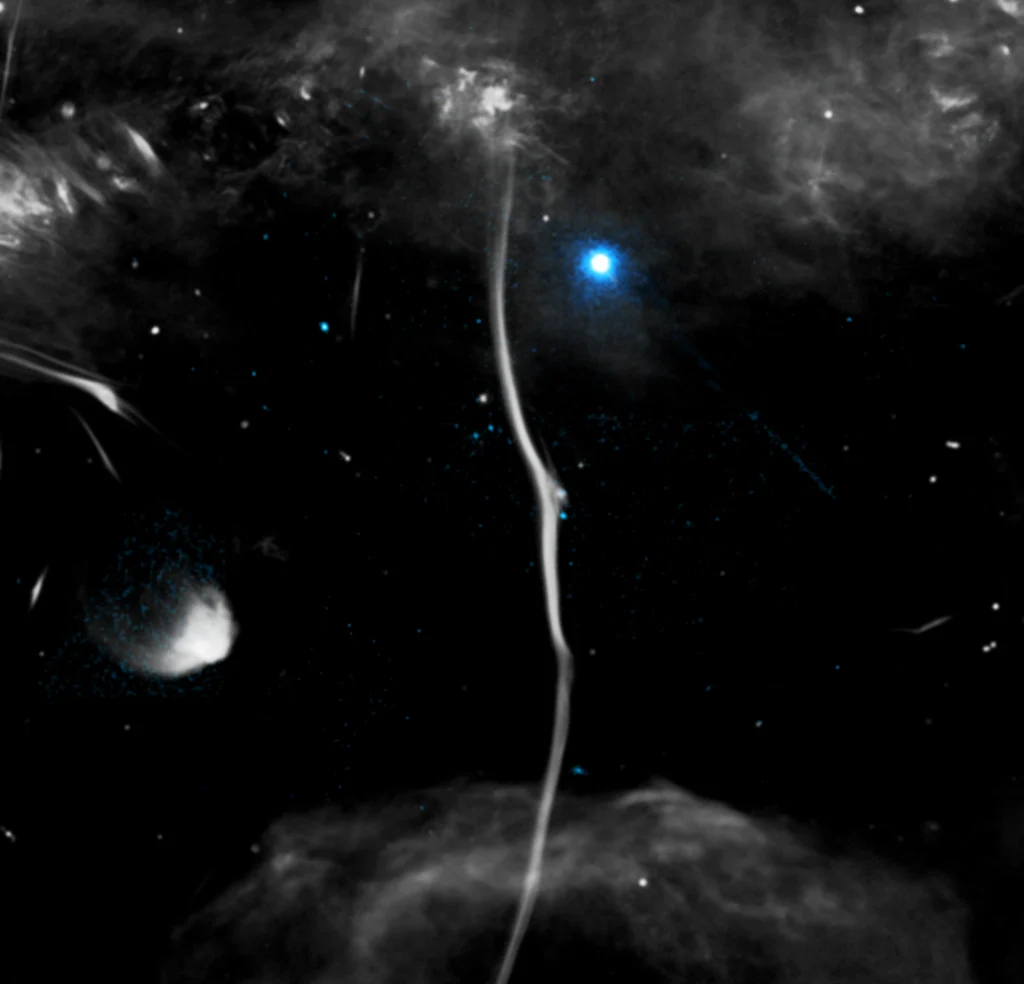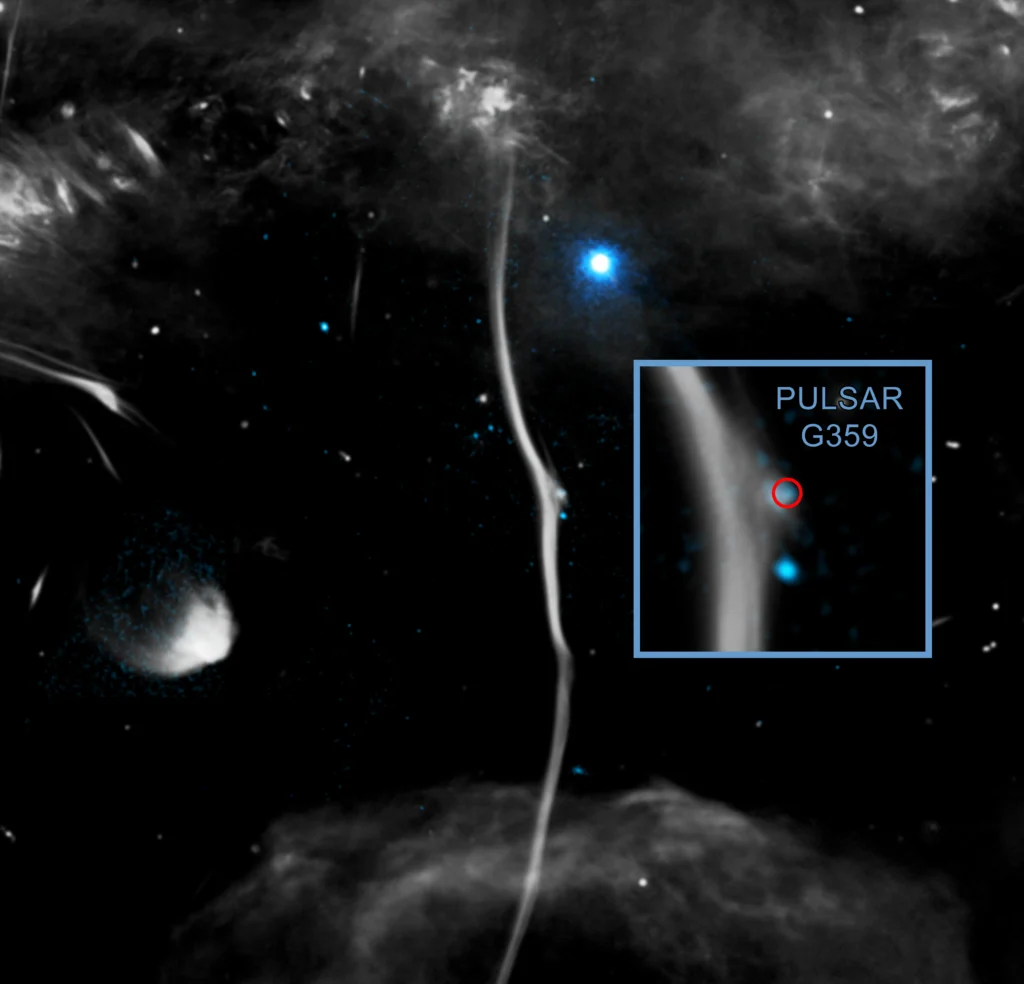
Introduction: A Cosmic Mystery Unfolds
In a stunning revelation that combines the prowess of X-ray and radio astronomy, NASA’s Chandra X-ray Observatory has helped astronomers uncover the likely cause behind a dramatic galactic bone fracture in the Milky Way. This cosmic structure—formally designated G359.13142-0.20005 and nicknamed “The Snake”—appears to have been split due to a violent collision with a high-speed neutron star, or pulsar. This discovery offers profound insights into both the dynamics of the galaxy’s center and the life cycle of massive stars.
What Is a Galactic Bone?
Astronomers refer to elongated filamentary structures located near the center of our galaxy as “galactic bones” or “galactic snakes.” These formations, visible in radio wavelengths, stretch across tens to hundreds of light-years and are threaded with strong magnetic fields. G359.13, one of the most prominent and brightest of these structures, extends for about 230 light-years and lies roughly 26,000 light-years from Earth, near the heart of the Milky Way.
These bones are thought to be shaped and sustained by powerful magnetic fields, with charged particles—electrons and positrons—spiraling along these fields, producing radio emissions. However, recent X-ray observations have shown that these seemingly static structures are not immune to disruption.
The Unexpected Fracture in the Snake
Using data from Chandra X-ray Observatory and radio telescopes like South Africa’s MeerKAT and the National Science Foundation’s Very Large Array, scientists observed something unusual in the previously continuous structure of G359.13. At one section of the Snake, there was a noticeable fracture—a break in the structure that appeared inconsistent with its otherwise seamless length.
This anomaly raised a major question: What could possibly fracture such an enormous and magnetically resilient galactic bone?
A Violent Intruder: The High-Speed Pulsar
The answer seems to lie in the form of a fast-moving pulsar, a type of neutron star left behind after a supernova explosion. Neutron stars are the densest stellar objects in the universe, often just 12 miles wide but heavier than our Sun. When these stars are born from massive explosions, they are frequently ejected at high speeds—sometimes exceeding 2 million miles per hour.
At the location of the fracture in G359.13, researchers detected a bright X-ray and radio source, likely a pulsar. This neutron star’s high velocity suggests that it may have smashed directly into the galactic bone, tearing through its magnetic framework and physically distorting the structure. The collision likely bent the magnetic fields and disrupted the spiraling particle flow, thereby causing the observed fracture in the radio data.
How Chandra and Radio Telescopes Worked Together
The combination of different observational technologies was key to solving this cosmic mystery. The Chandra X-ray Observatory provided deep-space X-ray imaging of the region, highlighting energetic processes such as the potential X-ray glow of the pulsar and high-energy particles surrounding it. Meanwhile, MeerKAT and the Very Large Array tracked the radio signals, clearly mapping the Snake’s length and identifying the precise location of the fracture.
This synergy allowed researchers to triangulate the pulsar’s origin and direction of motion, reinforcing the theory of a collision. Intriguingly, an additional X-ray source near the pulsar could indicate a stream of electrons and their antimatter equivalents—positrons—being accelerated to immense energies as a result of the impact.
Why This Galactic Bone Fracture Matters

Understanding a galactic bone fracture gives astronomers more than just an impressive cosmic photo—it provides a deeper glimpse into the dynamics of the Milky Way’s core. The galaxy’s center is a highly active region, bustling with star formation, dense molecular clouds, and intense magnetic activity. The interaction between a rogue neutron star and a magnetic filament like G359.13 demonstrates how energetic processes reshape even the largest structures over time.
This event also showcases how pulsars, often studied in isolation, can have galaxy-scale consequences. Their movement through the interstellar medium isn’t just fast—it’s capable of deforming massive, organized structures, warping magnetic fields, and altering radiation patterns across light-years of space.
The Scale of the Snake: A Galactic Giant
To comprehend the scale of this discovery, consider that G359.13 spans 230 light-years—a distance within which more than 800 stars could be found in our local stellar neighborhood. Despite being so far from Earth, the Snake’s distinct shape and bright emissions make it one of the most visible features in the radio sky.
It’s not just its size that impresses astronomers—it’s the integrity of the structure, likely preserved over millions of years, now suddenly and dramatically interrupted by a cosmic bullet.
The Team Behind the Discovery
The findings are detailed in the May 2024 issue of the Monthly Notices of the Royal Astronomical Society. The research was led by a diverse team of astrophysicists:
- Farhad Yusuf-Zadeh (Northwestern University)
- Jun-Hui Zhao (Center for Astrophysics | Harvard & Smithsonian)
- Rick Arendt (University of Maryland, Baltimore County)
- Mark Wardle (Macquarie University, Australia)
- Craig Heinke (University of Alberta)
- Marc Royster (College of the Sequoias, California)
- Cornelia Lang (University of Iowa)
- Joseph Michail (Northwestern University)
Their work highlights the importance of collaborative international astronomy, blending data from observatories around the globe to probe the very fabric of our galaxy.
NASA’s Chandra Continues to Illuminate the Unknown
Managed by NASA’s Marshall Space Flight Center and operated by the Smithsonian Astrophysical Observatory, the Chandra X-ray Observatory remains one of the most powerful tools for studying high-energy phenomena across the universe. Since its launch in 1999, Chandra has provided astronomers with unprecedented insights into black holes, supernovae, galaxy clusters, and now, the cause of a galactic bone fracture.
Conclusion: A Pulsar’s Trail of Destruction
The discovery of the galactic bone fracture caused by a high-speed pulsar reminds us of the dynamic and often violent nature of the cosmos. What appears to be a stable and unchanging structure—like the Snake—can be profoundly altered in an instant by a neutron star racing through space. These findings reinforce how little we truly understand about the interplay between gravity, magnetism, and stellar remnants in the galactic environment.
As astronomers continue to observe the Milky Way with next-generation telescopes, we can expect even more revelations about the hidden architecture of our galaxy—and the extraordinary events that shape it.
1 thought on “Galactic Bone G359.13 : NASA’s Chandra Uncovers Cause Behind Fracture”